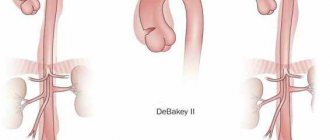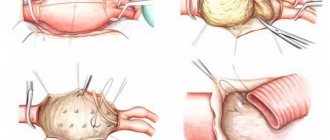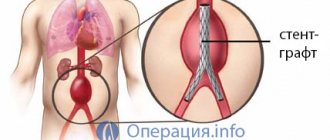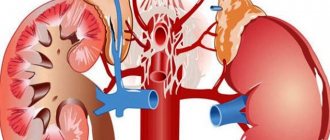Aortic enlargement is one of the most dangerous pathological prognoses. In another way, this phenomenon is called an aneurysm. Aortic enlargement is an extremely dangerous condition for the patient as it progresses, so in this case constant medical supervision is required. As a rule, with such pathologies a certain dilation of the vessel is formed. It is worth noting that no department is immune from aortic enlargement. However, it is the upward trend that is at greatest risk. It is worth familiarizing yourself in more detail with what aortic enlargement is, how diagnostics are carried out, as well as what treatment methods are used to treat this disease.
Sections of the aorta
The aorta is one of the two main vessels in the human body, connecting the left ventricle and its atrium. On the inside of this vessel there are three sinuses of valsalva. As a rule, the aorta moves blood from the heart to all other organs in the body and human tissues. The aorta is very similar in appearance to a tree, which has a trunk and small branches. The aorta is divided into several main sections:
- Ascending, moving from the aortic valve to the brachiocephalic trunk.
- The aortic arch is a not too long section of the main vessel, which is considered a key component of the entire circulatory system of the head and shoulder girdle. These vessels, which supply the head and shoulders, form a kind of arc connecting the ascending and descending sections of the main vessel.
- Descending or thoracic region. In this section, the vessels are located in the direction from the subclavian artery on the left side to the diaphragm.
- Abdominal part. This area is located from the diaphragm to the place where the main vessel, the role of which is performed by the aorta, bifurcates.
Treatment of sinus of Valsalva aneurysm
The abnormal structure of the sinus of Valsalva can only be eliminated with surgical treatment. In this case, the following actions are provided:
- Connection to a heart-lung machine.
- The protrusion is stitched and cut off.
- The defect site is covered with a synthetic patch from the side of the aorta or heart chamber.
An alternative technique is to retract the sac into the lumen of the aorta, then it is sutured and partially removed. The difficulty of performing the operation arises in the close proximity of the aneurysm and the coronary artery. In this case, preference is given to suturing the cavity from the side of the heart. At the same time, correction of other malformations or plastic surgery of the aortic valve can be carried out.
General description of the pathology
The expansion of the aorta of the heart itself is represented by an increase in the diameter of the vessel by approximately one and a half times, in some cases more. With this pathology, the walls of the dilated vessel lose their maximum elasticity, which negatively affects the speed of blood flow in the human body, as well as the state of blood pressure. All dilations of the aorta of the heart are usually classified into different groups, which differ in the area of localization, the main reasons for the formation of pathology, as well as the structure of the aortic walls. For example, based on the location of the expansion, the following types of aneurysm should be distinguished:
- Enlargement of the aortic root.
- An aneurysm affecting the ascending part of the vessel, starting from the sinotubular ridge and ending with the aortic arch.
- Expansion of the aortic arch.
What is the danger of dilatation of the aorta of the heart, who is at risk and treatment methods
As a result of pathological expansion, the walls of the artery weaken and lose their natural elasticity. Thinning of the tissue can subsequently lead to rupture of the aneurysm, which can have global consequences and even lead to death. The formation bursts under the influence of blood pressure and this can only be prevented by thickening the walls of the aorta.
Many people know that myocardial infarction is a common cause of death. There is no such widely available information about aortic enlargement, which is synonymous with an aneurysm. The disease occurs with a frequency of 5-20 cases per million, which is not much. The social and medical significance is that, if untreated, aortic dissection has a 90% mortality rate in the first 3 months from the onset of the disease.
Characteristic features of the violation
During this pathology, experts note a strong dilation of the vessel in the shape of a spindle or sac. Aneurysmal dilatation of the aorta can form in absolutely any part of this vessel. Since blood flows to various organs within the body precisely through the aorta, and this is facilitated by high blood pressure, the pathology is considered very dangerous for human health. An irreversible disorder is the expansion of the lumen of the main vessel.
Statistics show that about 38% of reported patient cases are due to dilatation of the abdominal aorta, about 24% to the ascending aorta, and about 18% to the aortic arch.
Main reasons for development
Diagnosis of this pathology should only be carried out by a cardiologist. After this, the specialist must prescribe methods for treating aortic enlargement. As for the main reasons for the formation of this pathology, it is customary to identify several:
- Various past infectious and inflammatory processes.
- The formation of cholesterol plaques on the main vessel, which is commonly called atherosclerosis in medicine.
- Some kind of vascular injury during surgery on the cardiovascular system.
- Congenital connective tissue dysplasia.
- Congenital valve disease in children.
- Presence of hypertension.
- Congenital aneurysm in newborns.
- Various genetic pathologies related to the type of Marfan syndrome and others.
It is also worth noting that during pregnancy, a process of increased release in the blood into the vessel begins to form in the female body, which is also the cause of the development of such a pathology. In addition, expansion of the ascending aorta or other part can occur due to addiction to alcohol or nicotine.
Causes, pathogenesis
Under the influence of the causative factor, nonspecific dystrophic phenomena develop in the aortic wall. Dystrophic changes manifest themselves as gradual thinning, disintegration of the vascular wall and the development of irreversible fibrous changes.
The affected area is stretched under the influence of blood flow, leading to a local increase in the diameter of the aorta, which is an aneurysm.
Causes:
- Atherosclerosis;
- Marfan syndrome;
- Syphilis;
- Smoking;
- Systemic diseases;
- Injuries;
- Hypertonic disease;
- Takayasu aortoarteritis.
The dilation of the vessel leads to abnormal blood flow and its accumulation in the area of the resulting protrusion. Disruption of systemic blood flow causes deterioration of blood supply and hypoxia of internal organs.
Oxygen and arterial deficiency provoke a reflex increase in cardiac output and blood pressure, which has an even greater pathological effect on the aorta. In most patients, this leads to acute dissection or rupture of its wall.
Dilatation of the abdominal aorta
This pathology is one of the most common. In most reported cases, this type of expansion is considered to be a consequence of blunt trauma to the abdominal area, as well as a consequence of smoking. Mostly men over 75 years of age suffer from this pathology. The danger of this aneurysm is that it almost always ruptures instantly, and this happens almost painlessly. But if the rupture is observed specifically in the abdominal area, then the patient begins to feel a cutting pain concentrated in the lumbar and abdominal area. If the rupture occurs unnoticed, then there is a high probability that the patient will die due to internal hemorrhage.
During the expansion of the abdominal vessel, a person may feel pain in the kidneys, ureters, pancreas, and also in the intestines. If the enlarged area presses on the ureter, this will provoke hydronephrosis. If the duodenum is subjected to compression, the patient will experience stagnation of the food eaten in the intestines.
It is important to note that the main sign of this pathology is considered to be constant pulsation concentrated in the navel area.
Aortic rupture and other complications of aneurysm
Rupture of aortic aneurysm
The most common and severe complication is rupture of an aneurysm with intense bleeding, collapsing and then shock, and acute hemodynamic decompensation. A blood breakthrough with an aneurysm of the thoracic or ascending part can be in the following locations:
- superior vena cava system;
- pericardium;
- pleural cavity;
- esophagus.
This leads to cardiac tamponade with cardiac arrest and respiratory failure. Any massive effusion of blood is accompanied by a sharp drop in pressure in the arterial system. If blood clots penetrate from the aneurysm cavity into the systemic vessels, then cyanosis and pain in the fingers and intermittent claudication join the clinic.
When blockage of the renal arteries occurs, hypertension and kidney failure increase, and blockage of the arteries in the brain causes a stroke.
When the abdominal aorta ruptures, the symptoms of pain in the abdominal area come to the fore, which is accompanied by constant intensification and radiates to the lumbar region and groin. In this case, the abdominal wall may be slightly tense, and palpation reveals a pulsating formation.
Arc extension
The aortic arch is the region of the main vessel that is most likely to develop an aneurysm. As a rule, in this area the blood flow sharply changes its direction. This is where the pressure, speed and turbulence of blood flow changes. As a result of all this, expansion of the aortic lumen may develop. Basically, arch aneurysm manifests itself in the form of shortness of breath and dry cough, dull pain in the shoulder blades, hoarseness, as well as constant pulsation in the wrist area.
Descending Area Expansion
As a rule, in this case the pathology has a spindle-shaped or bag-shaped shape. Both the abdominal vessels and the vessels belonging to the thoracic region suffer from this expansion. The main cause of enlargement of the descending aorta is considered to be cholesterol plaque. This type of pathology is detected during x-rays of organs, as well as vessels located in the chest area. As a rule, this pathology does not have any symptoms. Only sometimes can the patient experience constant burning pain in the upper abdomen.
Diagnostic methods
In general, aortic dilatation does not have any obvious symptoms or signs. Most often, this pathology is detected by chance during the diagnosis of any secondary diseases or during preventive procedures. If a specialist suspects an expansion of the main vessel in the human body, then he should prescribe the following diagnostic measures to the patient:
- Radiography. It is worth noting that x-rays are used in relation to the section where there is a suspicion of vessel dilation.
- Echocardiography. This diagnostic method is mainly used for dilation of the ascending aorta.
- MRI or CT scan of the main vessel of the abdominal or thoracic regions.
- Conducting angiography to evaluate the functioning of the main vessels.
It is important to note that quite often aneurysms are disguised as other pathological processes, which can cause a specialist to go astray. For this reason, it is necessary to differentiate an aneurysm from the formation of tumors and other pathologies that occur in the lungs or other organs located in the abdominal cavity.
What is the danger of dilatation of the aorta of the heart, who is at risk and treatment methods
- Reasons for expansion
- Symptoms of the disease and its development
- Dissecting aortic aneurysm
- Dilatation of the aorta of the heart: treatment
Enlargement of the heart's aorta, or aneurysm, occurs due to several factors that can cause the aorta to thin, weaken, and collapse. The aorta is the largest blood vessel in the human body. The aorta originates in the sternum and ends in the abdominal region of the human body.
There are two types of aneurysm: true and false. With a true aneurysm, the artery protrudes outward and is pathological. In this case, all three layers of the aorta protrude. A false aneurysm can appear after injury to an artery and has the appearance of a saccular protrusion in one layer. If after injury only the artery is damaged, then such an aneurysm is called an arterial aneurysm. And if a vein is also damaged, then this type is called arteriovenous.
Treatment with medications involves primarily prescribing drugs that lower blood pressure and heart rate. If the aortic lesion is viral in nature, for example, in the case of syphilis, then antibacterial drugs are prescribed. Enlargement of the aorta affected by a fungus is treated comprehensively with the prescription of antibiotics and antifungal drugs.
The operation involves plastic surgery of the aortic wall by installing a synthetic prosthesis on it. This disease practically does not occur in children (with the exception of congenital heart defects). Preventive measures may include maintaining a healthy lifestyle, controlling blood cholesterol levels, and exercise. It is important to undergo regular examinations, since aortic aneurysm is mostly asymptomatic.
If you notice any symptoms of enlarged aorta of the heart or one of them, you should immediately consult a doctor, as this disease progresses quickly. Irreversible consequences may occur.
The high-risk group for the development of the disease includes persons over 50 years of age, with constantly present elevated blood pressure, with ischemic lesions of the heart muscle, or who have suffered an acute myocardial infarction.
General clinical picture
If we consider the signs of dilation of the main vessel, then basically this pathology does not have any symptoms or signs. If pain appears, it is mainly localized in the area of the aneurysm and manifests itself in the form of pulsation.
First of all, the symptoms of various types of vascular dilatation are as follows:
- When the abdominal aorta expands, heaviness appears in the abdominal area, constipation, vomiting, decreased bowel function, and belching. During palpation, the specialist may feel a slight compaction that is pulsating in nature.
- As the ascending section expands, pain appears in the sternum area. In this case, the patient may also experience swelling in the upper torso, as well as on the face. Possible shortness of breath, dizziness and tachycardia.
- When the aortic arch expands, the patient develops a dry cough, bradycardia, and drooling. If the aorta is compressed in the area of the bronchi and lungs, pneumonia may develop.
Features of therapy
Treatment methods for dilatation of the main vessel should be based on the specific shape of the aneurysm, its size and location. If there is a slight expansion of the lumen of the vessel, then the patient can simply be observed dynamically. In this case, a support specialist may prescribe the following medications:
- Antihypertensive medications to lower blood pressure.
- Venotonics, which can strengthen the walls of blood vessels.
- Medicines that lower blood cholesterol levels.
- Various vitamin complexes to normalize metabolic processes in the myocardium.
- Anticoagulants to prevent blood clots.
It is important to note that all medications should be prescribed only by the treating cardiologist. Particular attention should be paid to the fact that no folk recipes for the treatment of this pathology are invalid.
If the lumen of the main vessel in the abdominal region is more than 4 cm, and in the thoracic region its size is more than 6 cm, then the patient will require surgical intervention. In addition, surgery is prescribed in cases where the patient’s lumen has increased in size by 0.5 cm in six months.
The principle of surgical intervention is based on the removal of a relaxed section of the vessel, or on its reduction. In some cases, a special prosthetic stent is installed. The operation can be organized either open or endoscopic.
Forecast and prevention of aortic aneurysm
In the absence of surgical treatment, aneurysms larger than 6 cm are complicated by rupture in half of the cases. The prognosis for this disease is unfavorable, especially with concomitant severe atherosclerosis. If an aneurysm is detected at an early stage and promptly treated by installing a stent or suturing, then such patients recover.
To prevent the formation of an aneurysm, you need to regularly monitor your blood pressure, avoid smoking and drinking alcohol, undergo a complete cardiac examination and be observed by a cardiologist.
If there is a risk of developing such a disease, periodic vascular ultrasound is recommended.
Aortic aneurysm is a life-threatening disease, as it can be complicated by rupture with massive bleeding and acute heart failure. Signs of an aneurysm depend on location and size. Characterized by unbearable pain, a drop in blood pressure, and a collapsed state. Without surgical treatment, the prognosis is poor.
Prevention of pathology
To never suffer from such an unpleasant disease, you need to seriously monitor your health. In particular, from a young age it is recommended to strengthen your blood vessels, for which you will have to give up the use of alcohol and tobacco. After 45 years of age, people should regularly monitor their blood pressure. If any problems are observed, you should seek help from a cardiac surgeon.
In conclusion, it is worth noting that a seemingly harmless pathology actually carries an incredibly great danger to human life. The fact is that the expansion of the main vessel can provoke a sudden rupture of the aorta at any time, which can cause instant death. Therefore, it is necessary to take the treatment of this pathology seriously and adequately. It should be remembered that any delay by the patient may cost him his life.
Disease prognosis
We also recommend reading: Acute left ventricular failure of the heart
The prognosis of the disease is considered unfavorable. From the moment the disease occurs and over the next five years, about 75% of patients die. Moreover, half die from aortic rupture, the rest of the patients - from concomitant pathologies - strokes and coronary heart disease.
There is a dependence of the threat of rupture of the aorta of the heart on the size of the aneurysm. Vessel dilatation of more than 5 cm is considered life-threatening for the patient. But in some cases, the patient's advanced age or other heart conditions can be more life-threatening than the presence of a small aneurysm.
Aortic rupture is an emergency condition that requires immediate surgical attention. If the aorta ruptures or dissections, emergency surgery is performed. Without it, the patient rarely lives more than a few days.











